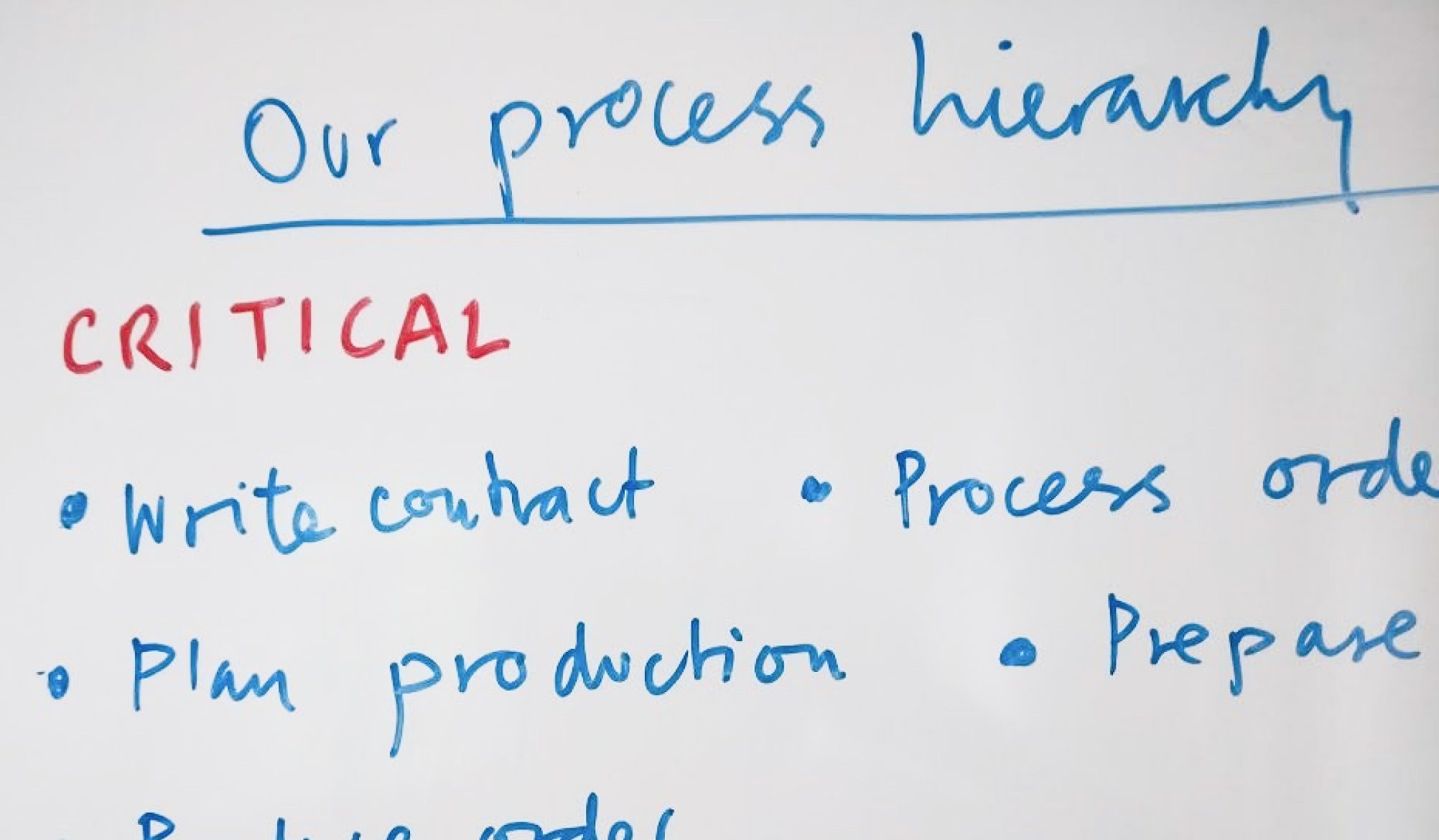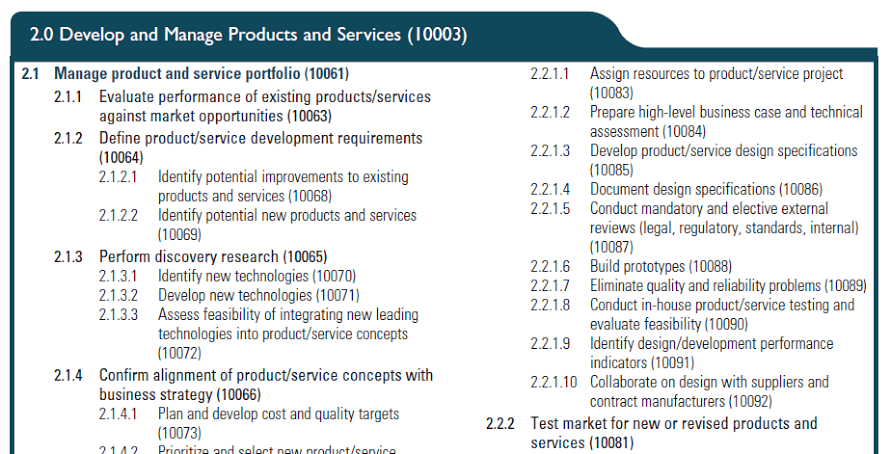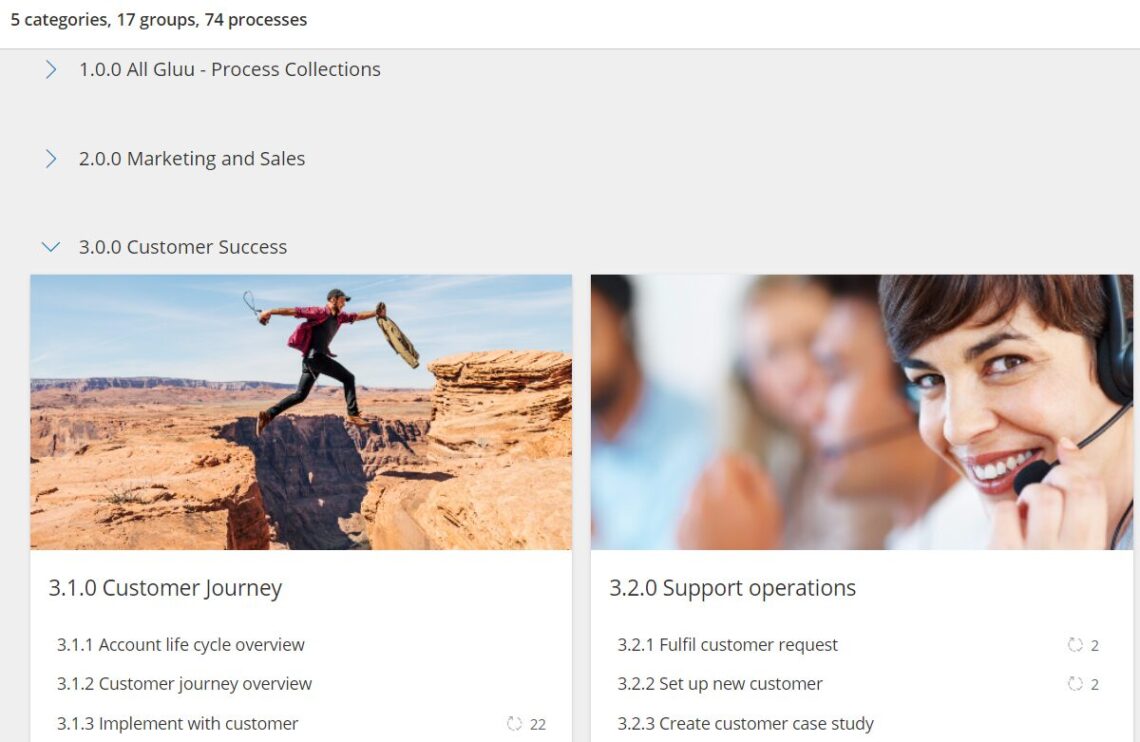
GLUU GUIDES
Guide to creating a process hierarchy
Most people think, “why should I care about a Process Hierarchy?” – a fair enough question. We know this guide might sound like a fast way to put yourself to sleep, but the surprising truth about the Process Hierarchy is that it can actually be an illuminating and rewarding business project. It’s a first step in shining a light on how you operate, where waste is happening, where fat can be cut, and how you can improve. This adds up to dollars and cents; a topic we all find interesting.
Whether you’re new to process hierarchies or just need a refresher, this guide will help you learn:
Table of contents
- Guide to creating a process hierarchy
- What is a process hierarchy?
- What’s in it for our business?
- A process hierarchy will help you answer some key questions
- Can we build a process hierarchy by ourselves?
- First steps to creating a process hierarchy
- Step 1: Start with the standards and systems you already have
- Step 2: Workshop critical processes with senior management
- Step 3: Focus on critical processes to start
- Step 4: Assign responsibility for each process
- Step 5: Decide on your format and tools
- Step 6: Assign a project manager
- Step 7: Manage your process hierarchy centrally
- Remember, this is just the first step
- Conclusions:
- Frequently Asked Questions
Looking for something else? Explore these related articles:
- 7 reasons process hierarchies go wrong
- Process Hierarchy
- 8 key ingredients for rapid process discovery
- Why creating a process architecture may keep your ship afloat
- Prepare your process blueprint and hierarchy (3/8)
What is a process hierarchy?
Before we start, let’s quickly recap what a process hierarchy – or process architecture – is.
A process hierarchy visually demonstrates all of the ongoing tasks within your business.
Think of it as being a little like an architectural blueprint for a house. Except rather than beams and rafters, a process hierarchy shows the processes that keep your business upright. They are also seen as a supplement to your organisational chart. The organisational chart shows how departments and roles are related, while the process hierarchy shows how activities are related and how they deliver the outcomes that are needed to attain your organisation’s goals. They map the small stuff, like how a receptionist should take a phone call, or how to send a late payment notice, to the very big and important stuff such as hiring a new head of a department.
Below you can see a sample process hierarchy for Product Development. This is a snippet from APQC’s Process Classification Framework® (PCF) which is the most used process framework in the world:

What’s in it for our business?
There’s a difficult, hard to impress person in every bunch so we’ll give you one simple reason: knowledge is better than ignorance. Process hierarchy is about knowledge and understanding. It ensures you’re not operating in the dark.
Familiarity, to tweak an old saying, breeds ignorance. We might think we know how our business works, but do we really? A process hierarchy will show us. It will reveal what recurring tasks we’re doing well, what could be better, where our blind spots are (the things we’re not seeing), places we could improve customer experience, where to eliminate waste, and even where economic, market and reputational risk could lie.
By documenting your processes you give your employees a common language and a clear understanding of their responsibilities. It will also allow you to continuously measure and incrementally improve the processes happening across your business, reducing waste and increasing efficiency. Having a process hierarchy really is a no-brainer.
Gluu’s founder, Søren Pommer, explains it in an interview:
A process hierarchy will help you answer some key questions
A well-made process hierarchy will show you how recurring tasks flow in your company. They help determine which individuals get to participate in which decision-making processes. They provide the foundation for your standard operating procedures and routines.
A process hierarchy allows you to optimise your business. By defining:
- Which processes are primary and which are supporting.
- What their intended outcomes or outputs are.
- Who they are executed by.
- How they are related to eachother.
A clear understanding of how your employees are going about their tasks provides the basis for insights into how to improve. It also shows whether you’re aligned with the correct procedure. For example, the EU has an upcoming law on personal data protection. With a process hierarchy, you could quickly dig down and confirm whether your company complies with such new legislation. And if you do have to make changes, it’s much easier to pivot and tweak things when you have processes already in place.
Still need some convincing? Take a look at this article: Why creating a process architecture may keep your ship afloat
Can we build a process hierarchy by ourselves?
Absolutely, process hierarchies can be highly complex and time-consuming. However, anyone can understand the fundamentals. With a bit of planning and help from guides like this, you will be well on your way to creating a professional, standard process hierarchy.
Depending on the amount of time you have, your level of enthusiasm and the complexity of your business you might take ownership of the project yourself or hire a consultant to lead the way. If you decide the latter, we advise you only use the consultant to facilitate the process. If they end up creating your process hierarchy from top to bottom then you and your team are unlikely to assume ownership. All too often this leads to stale or buried process hierarchies.
Regardless of whether you hire a consultant or not, it’s best to have a solid understanding of the basics.
”Well-designed BPM systems play a key role in minimizing growing pains by helping employees to navigate complex processes, increasing visibility into work queues, preserving as well as organizing institutional knowledge and reducing reliance on email-based processes.”
John Stretton

First steps to creating a process hierarchy
Now you know the basics of process hierarchies and what to include. Here are some tips on how to take the first steps:
Step 1: Start with the standards and systems you already have
If you already have a working quality management system then, as a start, simply transfer the table of contents to the process hierarchy format. There’s no point reinventing the wheel. So, make life easier as much as possible, model your process hierarchy on standards and frameworks you already have. Talk to your IT guys – they might have done something similar to prepare for a systems implementation.
Step 2: Workshop critical processes with senior management
Before you make any commitment to building a process hierarchy, getting management’s buy-in is absolutely essential. Ideally, this effort is driven by management, or someone close. This is best kicked off with a workshop that focuses on how your processes connect with your strategy.
Call on your best facilitator and get your top management team together for an offsite workshop to map the high-level end-to-end flows. This is a discussion about your business model and value stream and who is overall responsible for what. It is likely to get very lively and engaging.
Step 3: Focus on critical processes to start
Start off by finding the 10 to 30 processes that really matter. They’re the ones that keep the company running. If your outlook gets too broad too soon, and you try to nail down every single business process, you’ll get bogged down in the details and lose sight of the essentials.
⇒ Enterprises
Typically have HQ functions at a group level and then operate relatively independently at regional and/or country levels. Here it makes sense to create some common processes but we also recommend allowing “local offices” the freedom to create their own processes for how they work. Gluu has a feature that allows your subsidiaries to add group processes to their local accounts on an ongoing basis.
⇒ Small and Medium-sized businesses
Depending on complexity they may have between 30-200 processes. Here it is best to show end-to-end business processes first since this gives people a good overview of the business model. Each function or department can then have their own categories or process groups, and create their own processes as building blocks.
👉 Recommendation: To commence your process hierarchy, actively incorporate existing standards, engage senior management in a strategic workshop, and initially focus on 10 to 30 critical processes. This pragmatic approach ensures seamless alignment and prevents becoming overwhelmed by unnecessary details.
At Gluu, we start with our value chain overview. This contains links to all critical processes:

These are some of Gluu’s own functional groups and processes:

👉 Recommendation: Base your process hierarchy on your value chain (core and supporting processes in your product/service delivery) instead of your organisaitonal chart. The latter is the most intuitive for most people as this is the way we are used to thinking of our company, but opting for the former has so many benefits. Watch this TEDx to understand one of the reasons why: The efficiency paradox.
How to do it: Instead of assigning a category to each department in your company, assign a category to each of the major steps in your value chain like: 1. Inbound Logistics, 2. Operations, 3. Outbound Logistics 4. Marketing and Sales 5. Services + supporting categories like HR, IT, etc, if you want to follow Porter’s model.
Step 4: Assign responsibility for each process
Assign responsibility for each of the critical processes to specific team members. Some of these people will be obvious, like department heads in a big company, but in some cases, they won’t be and you’ll need to investigate who’s who.
We encourage you to assign process ownership at the lowest level possible, meaning instead of assigning all processes to department heads, try assigning ownership to the person responsible for the execution of the process. In doing so you will see a much higher adoption rate and you will encounter less resistance when implementing new processes – especially if you also involve the people actually working in the process in mapping it and later in improving it.
Step 5: Decide on your format and tools
Next, you’re going to need a way to visually map your processes. Key for success here is that whatever tool you use, it must be shareable and easy to collaborate company-wide. If it stays in one room, it will end of up dead and forgotten. This is where online platforms, such as Gluu, come in. To explore tools for managing and optimizing your business processes, check out our BPM Software Selection Guide to identify the right solution for your organization.
Step 6: Assign a project manager
When it’s time to take the project out to the whole company, you’ll need a project manager to lead the way. Choose someone with a broad understanding of the business, and someone who can talk to people both in the boardroom and on the shop floor.
Step 7: Manage your process hierarchy centrally
We’re all for decentralisation and involving everyone. However, when it comes to your process hierarchy (and your roles for that matter) then agree on only a few administrator positions who are allowed to change things. You want everyone participating, yes, but maintain control centrally.
⇒ Process names and outcome descriptions remain consistent.
It can be very confusing if one process is “Onboard new customer” and another is “Customer management”. Stick to one semantic style (we recommend using active language such as “Manage processes” and yes, you should have a process for managing processes.
⇒ Processes don’t overlap (too much).
Each process should have a very clear name and outcome. This sets the scope and ensures that you minimise overlap when other people start mapping theirs. If this initial map of processes isn’t clear, then you’re likely to see confusion when others start mapping.
⇒ Processes become easier to link with each other.
Getting the initial overview and understanding of end-to-end flows makes it easier to link processes and show which are related. This gives understanding and insights into the process mapping exercises that come later.
👉 Recommendation: To streamline process mapping, actively assign responsibilities, opt for a collaborative platform like Gluu, appoint a capable project manager, maintain centralized control, ensure uniform process names, minimize overlap, and enhance linkages for clear insights.
Remember, this is just the first step
Creating a process hierarchy is just a first step towards success with business processes. While it is valuable on its own, the real value will come when you start mapping processes, adding work instructions and then executing and improving them.
Conclusions:
Understanding and implementing a process hierarchy is crucial for illuminating business operations. It provides clarity, identifies areas for improvement, and ensures compliance. Whether you’re a large enterprise or a small business, starting with existing standards, engaging senior management, and focusing on critical processes lays the foundation. With the right tools and a centralized approach, the process hierarchy becomes a dynamic tool for continuous improvement, collaboration, and strategic alignment throughout the organization.
Frequently Asked Questions
A process hierarchy is crucial as it provides a clear blueprint of ongoing tasks, helping identify areas for improvement, reducing waste, and ensuring strategic alignment with organizational goals.
By recording processes, a common language and a common understanding is established, responsibilities are clarified, and continuous measurement allows for incremental improvements. This fosters collaboration, reduces waste, and enhances overall effectiveness.
While process hierarchies can be complex, understanding the fundamentals is attainable for anyone. With planning and resources like guides, businesses can create a professional standard process hierarchy. Professional assistance may be considered based on complexity and enthusiasm, but active ownership is recommended.
